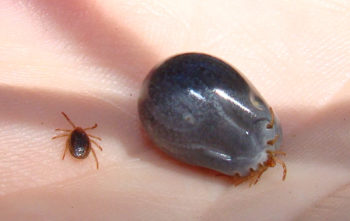Straight Talk About Ticks
Ticks are here, and their numbers seem to grow exponentially. Sometimes it might feel like the only solution is to retreat to our paved and chemically treated human environment, but we simply should not accept this. As our world becomes increasingly digital, virtual, and sedentary, a solid connection with the real world should include time spent out in the forests and fields, engaging  with nature, and observing the natural rhythms of the planet. This is true for our children, as much or more so than it is for adults, and we do them a disservice later in life by keeping them inside or by making them afraid of the outdoors.
with nature, and observing the natural rhythms of the planet. This is true for our children, as much or more so than it is for adults, and we do them a disservice later in life by keeping them inside or by making them afraid of the outdoors.
The good news is that by taking the proper precautions, we can get outside and explore safely. There are a number of recommendations from tick and Ly
me disease experts. If you can’t do all of them every time, do what you can. Every ounce of prevention is better than a pound of cure for tick-borne diseases. Recommended precautions include:
- Walk in the middle of trails; avoid sitting on logs and leaning on trees;
- Wear a hat, tuck in hair, if possible;
- Wear a long-sleeved shirt fitted at the wrist;
- Wear shoes, no bare feet or sandals;
- Wear long pants tucked into high socks or duct tape around pants
- Consider tick repellants such as Deet or permethrin;
- Wear white or light-colored clothing to make it easier to see ticks
Along with these recommendations, you should always do a tick check immediately and for 3 days after outdoor activity, for everyone including dogs. For people who love the outdoors that amounts to a daily tick check, so commit to the ritual of a thorough check of your entire body every day during tick season.
What Can Scarborough Land Trust Do?
Many people have asked what the Scarborough Land Trust is doing or could do to help alleviate the problem. The truth is that any effective remedy to treat our entire trail system would be frightfully expensive, and would most likely involve unacceptable impacts to the environment. SLT has experimented with homemade “tick tubes.” These are toilet paper rolls that are stuffed with cotton balls that have been treated with permethrin. Permethrin is a chemical that repels and/or kills ticks, and it is commonly used to treat clothing or outdoor gear. After the tick tubes are dropped out of sight along a hiking trail, mice will tend to use the treated cotton balls to line their nests. Ticks are unable to feed on mice that live in a permethrin-treated nest, so the overall density of ticks should go down in an area treated this way.
This approach is being tested in many places and the jury is out on whether it will significantly help the tick explosion. Permethrin is also toxic to bees and some other beneficial insects, but the targeted use in mouse nests should minimize any contact with these helpful insects. The actual volume of pesticide that is being put in the environment is vanishingly small when spread out over hundreds of acres of land, and permethrin will eventually break down in the sun or by the action of microorganisms, so undesirable environmental effects are minimal. SLT is monitoring the research on this issue and will change course if evidence indicates that this approach is ineffective and/or damaging.
The other action that SLT can take, and is taking, is to try to educate the public about this issue. We have new signs going up within days that highlight the presence of ticks on the trail, and provide pointers like those above.


